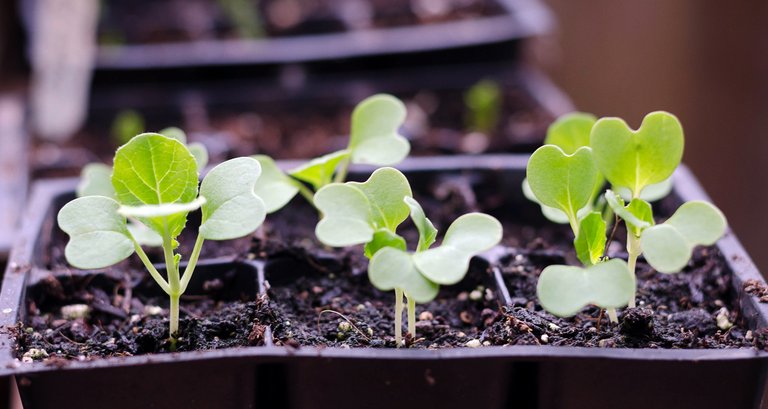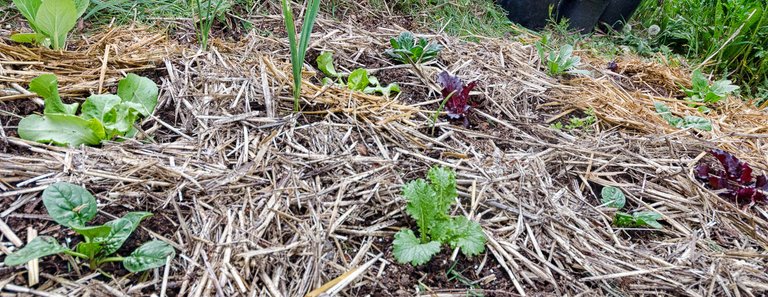Some gardeners like to believe that there’s no way to avoid transplant shock. Even worse, some even believe that transplant shock doesn’t matter—that it’s just a normal, unavoidable course of events that doesn’t really hurt the plant. This can’t be further from the truth. Transplant shock weaken your plants, making them more susceptible to disease and predation (something particularly significant if you’re transplanting them into their final beds). The good news is that it’s generally avoidable. All you need is a bit of care and proper handling.

Bok Choy seedlings recently transplanted.
What Causes Transplant Shock?
The main cause of transplant is damage to a plant’s roots. Plants absorb most of both their moisture and nutrients from root hairs that grow sideways off the roots. They’re tiny and grow far from the root ball in order to maximize their absorption area. They’re also very easy to damage when exposed to light, heat, or any kind of abrasion. The more you can protect these little hairs (and the roots in general, of course), the less likely your plant is to get transplant shock.
Here’s what to do:
- Make sure to harden off your plants before planting them outside.
If you’re moving plants that were grown inside to an outside location, they’ll need to be “hardened off” before being planted in your garden. Hardening off allows the plant to gradually adapt to its new outdoor environment—abrupt changes such as direct sunlight, moisture-zapping wind, and very different temperatures can cause your plant to be far more stressed than it needs to be. Lots of people skip this step because it’s sort of a headache, but it’s not advisable. Plants that aren’t hardened off not only have much more transplant shock, they also tend to be more prone to diseases and slug damage.
To harden your plants off, start by setting them out in the early morning or late afternoon (not the heat of the day) for four hours. The next day, let them stay outside for eight hours. The next day, twelve. Etc. Once your plants have been outside overnight for at least three days, they’re ready to plant into the ground.
- Avoid transplanting in direct sunlight, and even avoid hotter parts of the day.
- Water the soil (not the leaves) of the transplant a good 30-60 minutes before transplanting.
- Add a bit of transplant fertilizer to the soil before planting.
- Disturb the roots as little as possible.
- Water well after transplanting
- Don’t tamp the soil around the plants down.
Cool, overcast days are the best days to transplant, but if that’s not in your weather forecast, set up your transplanting station in the shade. Roots were made for the dark, cool nether regions of the earth. They’re easily damaged by light and heat. And while I’ve seen more than one careless gardener leave their transplants out with their roots exposed to the sun—don’t do that, even for a moment if you can help it. It places an exorbitant amount of stress on your plant, aside from being a sure fire way to get transplant shock.
Tip: If you have to plant out in the sun, position your body between the sun and the plant, using your shadow to provide shade.
Giving a good watering beforehand ensures that your plant is well nourished before being moved. This is important because one of its first reactions will be to close its stoma, stopping it from taking in water through its leaves. Filling up its tank beforehand ensures that it has plenty of time to ease into things. Also, moist soil helps you minimize friction against the roots. That means less damage to the roots overall and a speedier recovery if the root ball somehow gets disturbed.
Fertilizer made especially for transplants has everything they need to get settled in with the least amount of stress. You can get a dry form to put in the soil before planting (what I use) or a liquid form to put in after planting. You can also make your own.
The plugs I plant in are small, so I often have to transplant when the seedlings are very young.
The ideal transplant is to not bother the roots at all, but this is often impossible. So do your best. Try to transplant well before the plant has filled the soil with roots and become root bound.
Believe it or not, insufficient water is one of the greatest contributors to transplant shock (after disturbing the roots). As mentioned before, if you disturb a plant’s roots, it won’t be able to take in water through its leaves for the next few days. This means having plenty of water available in the soil is crucial.
The bok choy seedlings before they were transplanted.
And that's it. If you follow these instructions you should rarely, if ever, see transplant shock. As you can see form the pictures, I often germinate in plugs that are quite tiny and need to up-pot pretty quickly--often before there are two true leaves on the seedlings. I still have absolutely no problems with transplant shock--even when I have to separate two plants out from each other.

Transplants happy in their new home.
Have questions or suggestions? Let me know.
Did you find this article helpful? Please upvote and resteem!

Community Forums
 )

 )
)
We did this once, transplanting in the wrong way. All the spinach died. The problem was that we did not realise the amount of sunlight that the plant was now exposed to. Roots are very delicate and as you say, the can so easily be damaged when transplanting. I always take as much of the soil around the plant as possible to avoid damaging any roots.
I always do the transplanting in the evening so the plants can rest through the night.
Thanks! Forgot to put that in.
About watering, my father thought me, after transplanting, make a hole about 10 cm away from the roots of the plants and water the plants through that hole. This way the soil won't become muddy around the plants and they can breathe.
I use the water to settle the soil (instead of tamping). Just have to make sure the soil isn't already waterlogged. If it is, I just add some non-water-logged soil along with it. But generally I keep my garden beds mulched unless I'm heating up the soil, so they're rarely overly wet.
Great post, & profile ! We needs more gardeners on this planet
wow, those plugs are so, so tiny! definitely resteeming & keeping this in mind - water wise - when i transplant soon. i've gotten better at hardening off, but there's always something that gets a bit wonky, and i bet it's usually related to not watering well enough.
Yeah, those plugs are indeed tiny. I didn't like them at first, but now I'm sold on that tray. Wish I could find more. I don't end up wasting any seed like I do when I plant in flats. It's also really rigid plastic that doesn't break easily or degrade.
they sure don't make things like they used to, right? i picked up some new flats this year and the plastic - both on the trays and the lids - is SO FLIMSY. it's disappointing!
That's the main reason, I think, to use actual just straight potting soil in flats and not plugs or plastic trays. Luckily you can get the larger pots for free most places (folks are always getting rid of them), but the starter plugs are hard to find for free and break apart pretty quick. The unit in the picture was given to me...I haven't been able to find it online or at any store.
very true. i am keeping my eyes & ears open over the next few months, as people will likely be getting rid of stuff soon - i want to start planning for next year!
I like your photos and we are soon to be getting ready to garden.
These look like healthy transplants.
Looks like you're taking great care of those wee plants. Great tips you're included! it's satisfying to see plants happy isn't it?
Would be interested to know if people do this type of transition in places like Canada/Alaska, where the climate is a bit harsher....
Good post.
I'm pretty sure the hardening off process is the same. You might take a bit longer to do it, though. Some people suggest going from a greenhouse to a cold frame first, before planting outside. (That makes it about 2 weeks of hardening off.)
As far as transplanting, though, the process is the same.
Good information...thank you for sharing. I've found a small plastic spoon fits down into my starter peats and lets me slide the babies out gently.
Congratulations human. This post is featured in today's Muxxybot curation post.https://steemit.com/curation/@muxxybot/muxxybot-curation-68
nice!
I will definitely make a note of this post! I often notice that my transplants suffer. I didn't realize that the root were that delicate.
What an excellent post! Any stress or shock to a plant weakens it and reduces it's production and health. Well written and lots of good points to take into consideration.
Some plants, like squash, absolutely hate their roots disturbed. Others, like alliums or Swiss chard, don't seem to mind as much.
I've resteemed so more people can see this!
Congratulations! This post has been added to our growing directory of Steemit "how to" posts for the Homesteading/Survival/Foraging/Prepper communities. If you haven't done so already, you can claim your badge along with the code to add to your posts to let the world know you have chosen to help others Survive, Thrive and be Prepared! Click here to get the code
Hi @sotall, does this badge only apply to this post?
Awesome tips! I am trying to help with transplant shock as much as possible this year, so this is very helpful.
Hello @teryani,
Just wanted to say hi and let you know that your wonderful post have been picked up for the weekly Sustainability Curation Digest in association with Minnow Support Project.
Your post will be upvoted by @msp-curation bot on behalf of MSP.
Thanks for writing awesome content and if you have some time, make sure to check out some of the other posts from this week.
Sustainability Curation Digest #1 🌄🌍🌝 by Carpedimus - MSP
Keep up with the great work :)
Great tips and reminders. I have learned the hard way by giving too much sun exposure too quickly for garden veggies or taking house plants outside for summer. You have to harden them off. Great post!